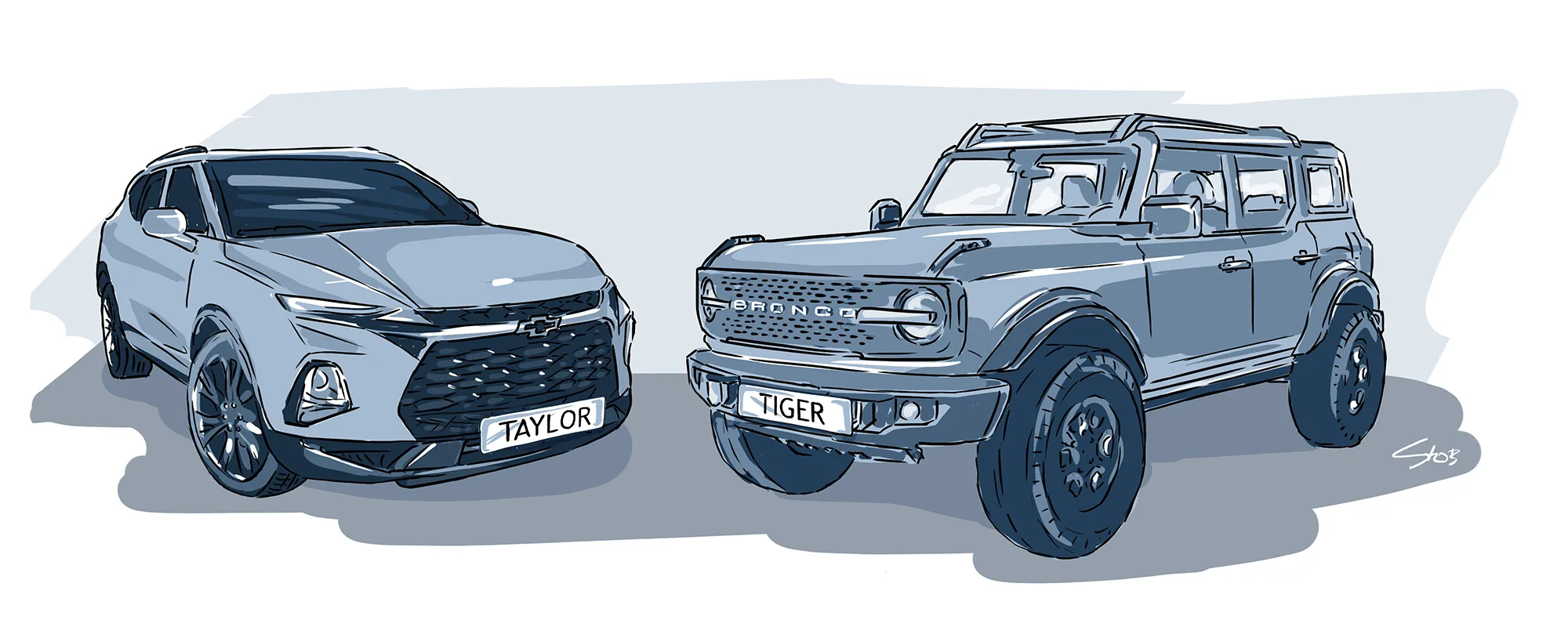It is nothing new for brands to try and relaunch old classics in an attempt to tap into the consumers’ longing for “the good old days”. Over the last couple of years, both Chevrolet and Ford tried to emulate success from a bygone era by reviving their Blazer and Bronco brands, respectively. The automakers certainly took differing approaches to resurrecting their off-road legends, leading us to explore what factors we believe lead to a successful automotive relaunch.
They say that legends never die… unless executives at big automakers manage to kill them.
In the automotive world, brands often attempt to resurrect their “legends” by re-introducing nostalgia-inducing and iconic monikers as all new cars for the modern age. Over the last couple of years, two relaunches have particularly caught our eye. Chevrolet’s resurrection of the Blazer in 2019, and Ford’s revival of the Bronco this past summer both stood out as differentiated attempts to leverage particularly iconic off-road names from a bygone era that are still recognized by consumers today.
Like all industry professionals (and car enthusiasts), we have our own opinions on just how well each company executed their respective model rebirths. With that in mind, we want to take a closer look into the good and the bad of the new Blazer and the new Bronco, as well as the factors that we believe are the foundation for a successful relaunch. Given our expertise in sales strategy, our evaluation will consider both the success – presumed or actual – of the model, along with our view of the effective utilization of the valuable nameplates.
Defining Relaunch Success
So what makes a relaunch successful? Given our experience, we believe that success can be boiled down to three key criteria that automakers should strive to hit. These criteria pertain to: brand value, car value, and monetization strategy. In order to see the importance of these factors, one needs to look at just a single brand to find the difference between a successful relaunch and an unmitigated disaster.
Next time you’re on the road, count the number of Dodge Challengers and Chargers you see. My guess is you won’t come up empty. There’s one doing a burnout at just about every red light in America. At the same time, be on the lookout for a Dodge Dart. If you see one those unique-looking family sedans, send us a picture… otherwise we probably won’t believe you.
With this in mind, let’s take a deeper look into the factors that we believe can make or break a relaunch:
1. Brand value: Build the car around the brand
Recognizing the value of a brand is crucial to executing a successful relaunch. By building a car that is consistent with and additive to an established brand, automakers generate nostalgia-driven hype and excitement, while capitalizing on existing brand equity that can be leveraged for future success. Case-in-point, the new Challenger and Charger looked, felt, and performed like Challengers and Chargers of old. As such, Dodge’s performance twins have stuck around as cash cows for over a decade essentially unchanged. Meanwhile, the new Dart family sedan could hardly even be associated with the striking, V8-wielding Darts of the past, meaning Dodge’s leverage of the Dart brand started and ended with the shared name.
2. Car value: Build a car that consumers want – regardless of the name
Know your customers, know your market, and know your own strengths. When Dodge brought back the Charger and Challenger, they did so by identifying and filling an underserved demand for American sport sedans. Dodge correctly analyzed the market, saw the resurgence in the muscle-car segment and gave their customers what they wanted – athletic vehicles with impressive performance figures. Conversely, when Dodge released the Dart, small car demand was dwindling in favor of SUVs, and the car itself wasn’t particularly competitive. Couple light consumer demand with a car that was neither the sportiest, most practical, nor most economical option in a hotly contested market, and you ultimately got a vehicle that was later called “the least financially rewarding enterprise that [Fiat Chrysler] carried out” by the legendary FCA executive, Sergio Marchionne.
3. Monetization strategy: Know your worth
The Challenger is so iconic to its legions of fans that Dodge can get away with charging top dollar for the tire-shredding trims, which in turn allows them to better monetize the more pedestrian versions through price anchoring. For example, you can buy a Challenger for anything from under 30,000 US dollars to nearly six figures… and every trim in between manages to sell. This is very well done and deserves credit to the aptly named Kevin Hellman, Dodge’s brand manager in charge of the Challenger. Additionally, his “10 dollars per horsepower” strategy to incite upselling strikes us as a fitting monetization strategy for a performance oriented brand.
So what about the Blazer and the Bronco?
With the three criteria for relaunch success established, we can turn our attention to the relaunched Chevrolet Blazer and Ford Bronco.
Chevy Blazer
Overview: Let’s get one thing out of the way. The new Blazer is not the hardcore off-roader that enthusiasts clamored for. Chevy is smart enough to realize that enthusiasts don’t pay the bills – regular people do. That is why the new Chevy Blazer was introduced as a mainstream, midsized, two-row crossover that has steadily sold off of lots while being skewered in every car blog in America that only the enthusiasts read anyway.
- Is the Car Built Around the Brand? Absolutely not.
Chevy built this crossover to slot nicely between their Equinox and Traverse models, and they added some sharp lines to the body to make it appear “aggressive”. This car is a “Blazer” because Chevy says so, knowing that giving their otherwise pedestrian vehicle a recognizable name would allow it to somewhat stand out in the crowd. While we personally don’t love this appropriation of a legendary moniker, Chevy can do what they wish with their patents. - Does the Modern Consumer Want it? Clearly, yes.
Figures show that in the third quarter of 2020, the Blazer sold nearly 30,000 units, only being outsold by the Jeep Grand Cherokee in the two-row midsize mainstream crossover segment. Demand for the Blazer is so high, GM is barely able to keep up production. Clearly, GM did their research, auto bloggers be damned. - Is the vehicle positioned to maximize monetization? For the most part, yes again.
The Blazer is competitive in the space, starting under 30,000 US dollars, with fully-loaded models creeping up into the 40s. This makes the Blazer affordable but not “cheap”.
Had Chevrolet made more of an effort to build the Blazer with some actual off-road pedigree, then they could have positioned their most-capable models alongside the Jeep Grand Cherokee Trailhawk or Overland models (starting in the mid-to-high 40s). This would have made the lower trims seem like a great value by association (similar to the Charger and Challenger example earlier). Instead, Chevy took the route of introducing an associated little brother “Trailblazer” model (just to upset the enthusiasts a little bit more) that shares many styling cues and starts under 20,000 US dollars. This move seems to have paid off for Chevy, as the Trailblazer was the fastest-turning vehicle in the industry in Q3 in 2020.
Other Thoughts: Would the Blazer have been as much of a success had it been named the “Trekker”? Who’s to say? However, we certainly believe that Chevrolet could have saved the “Blazer” name for a more proper relaunch down the road. Given the ubiquity of the Jeep Wrangler and Ford’s continued teasing of a Bronco resurrection since the 2004 concept vehicle, Chevy had to have known for years that the off-road space was going to become more prominent. Now, if they want to try and compete with their own hardcore off-roader, they will have to do so without their most valuable and logical nameplate, likely causing them to miss out on heritage-driven hype a-la the new Bronco. It seems then that Chevy could have left the “Blazer” bullet in the chamber just a bit longer without sacrificing much in the process.
Final Verdict: The Blazer is the Taylor Swift of Cars. They both used to be country but sold out to the mainstream and made a lot of money in the process
Ford Bronco
Overview: After teasing a relaunch for the past decade and a half, Ford finally introduced the new Bronco lineup to incredible fanfare and a glowing reception from journalists, enthusiasts, and wannabe cowboys everywhere. Regardless of how many units Ford actually sells, the Bronco got people talking about the Blue Oval once again, to the tune of 3.5 million views of the launch video on Youtube, and well over 150,000 reservations through 100 dollar deposits (75 percent of which Ford expects to convert into firm orders). The Bronco is built to compete with (and dethrone) the almighty Jeep Wrangler as the dominant off-road SUV on the market. Initial figures and specs suggest that Ford just might pull it off.
- Is the Car Built Around the Brand? Absolutely. To say that Ford built the Bronco around the brand would be an understatement. The Bronco is built as true-to-form as one could ever hope. It’s an open-air, aggressive, customizable, off-road focused SUV that is supremely capable and most importantly recognizable, having taken direct inspiration from the highly sought-after first generation Broncos from the 1960s.
- Does the Modern Consumer Want it? It certainly seems that way. With only one real competitor in the game, there should be plenty of demand left for the Bronco. The Jeep wrangler may be one of the top 20 selling cars in the US with over 225,000 units sold in 2019; however Jeep also gave Ford the “answers to the test” so to speak by producing, marketing, and selling four generations of Wrangler. Therefore Ford has the perfect case example to mold the Bronco and fix anything that is wrong with the current Wrangler. With that much data and reference material, it seems inevitable that the Bronco will be a hit!
- Is the vehicle positioned to maximize monetization? It would appear so – but not for the reason you may think. The new Bronco’s pricing essentially mirrors that of the Wrangler (as it should). Given that customers will undoubtedly take advantage of a large aftermarket catalog, Ford offers trim levels from the sub 30,000 US dollar bare-bones steel-wheel base model to the twice-as-expensive limited First Edition model with upgraded everything.
In our opinion, the true genius of Ford’s Bronco’s pricing lies with the Bronco Sport. By introducing a slightly lower-priced crossover alongside its capable big brother, Ford allows some of its off-road pedigree to trickle down in order to differentiate its more pedestrian offering. In essence, while the Blazer rests on the laurels of its predecessors from the 90s, the Bronco Sport benefits from direct association with a new and exciting rock-crawler (despite being based on the Ford Escape). Upon release, we will gain a better understanding on how much of a difference this association really makes.
Other Thoughts: The Bronco seems to do just about everything right. In addition to becoming a probable success in the showrooms, it additionally lifts up the entire Ford brand as the company transitions towards an SUV-centric strategy. The only place where Ford could have improved would be if they “went for the jugular” and offered a V8 option for the Bronco at launch. After years of one-off builds, Jeep finally answered their loyalist’s prayers by announcing a production-ready 6.4L HEMI V8 Wrangler that does 0 to 60 in 4.5 seconds (almost as quick as a BMW M440i). Ford could have taken the wind out of Jeep’s sails by offering a “Raptor” variant of the Bronco at reveal, but instead they will have to play catchup with the top-of-the-line Wrangler upon release.
Final Verdict: The Bronco is the Tiger Woods of cars. Both were beloved early on, ran into some bad publicity that led to a bit of a hiatus, and are now back with some shiny new parts hoping to reclaim the throne
Tying it all together
Given the plethora of retired monikers that are prime resurrection candidates, we believe that the trend of new models taking on old names is here to stay. So long as automakers recognize the brand equity tied to some of these models, relaunches can be a perfect way to build hype for a new vehicle and prop up an entire brand! With that in mind, we would love to hear from you. Please reach out to us, you can find our contact information at the top of this page. A few questions to consider:
- What do you think of the trend of relaunched models?
- Are there any relaunches that you would like to see happen in the future?
- Do you think Chevrolet or Ford made any mistakes when relaunching the Blazer and the Bronco?
- What other lessons do you think automakers can learn from these and other examples of relaunches?
We are more than happy to discuss, so feel free to either answer our questions or give us your general thoughts via direct message.








